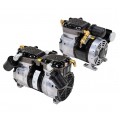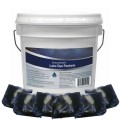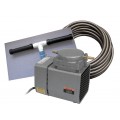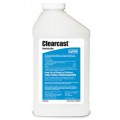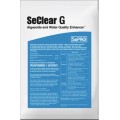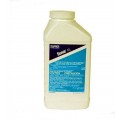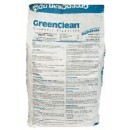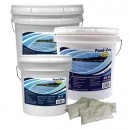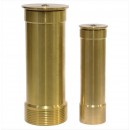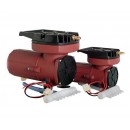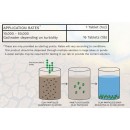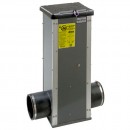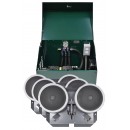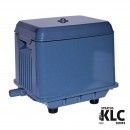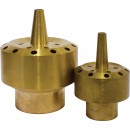Shopping Cart
0 item(s) - $0.00- Pond Sealant
- Aeration Systems
- Air Pumps & Compressors
- Algae Control
- Algaecides & Herbicides
- Bacteria & Clarifiers
- DC Compressors & 12V Pumps
- Diffusers & Airstones
- Dock Bubblers & Deicers
- Dyes & Colorants
- Fountains
- Large Ponds & Lakes
- Muck Removal
- Nozzles & Fountain Heads
- Pond Liner
- Pond Pumps
- Tubing & Accessories
- Water Level Control & Gates
- Water Treatments
- Windmill Aeration
- Commercial & Industrial Supplies
- Solar Aeration
-
Information & Articles
- - Aeration: The Key To Success
- - Air Compressors: Rotary Vane
- - Air Pumps: Linear or Diaphragm
- - Airline & Tubing for Aeration Systems
- - Algae Control
- - Aquatic Plants & Weeds in Ponds
- - Building A Dock Bubbler System
- - Building A Pond: The Basic Steps
- - Calculating Dissolved Oxygen Levels
- - Compost Aeration & Compost Tea
- - Diffusers: The Key To Efficient Aeration
- - Dock Bubblers & Deicers
- - Duckweed Control
- - Fountain For Ponds, Lakes & Small Gardens
- - Grease Trap Bacteria & Enzymes
- - Mosquito Control in Ponds
- - Muck: Removing Sludge & Pond Muck
- - Pond Aeration Systems
- - Pond Dyes: Aesthetics & Growth Control
- - Pond Liners
- - Pond Pumps: Submersible & External
- - Pond Winterization: Prepare Your Pond for Winter
- - Septic Bacteria Treatments
- - Solar Aeration, Solar Pumps & Solar Systems
- - Solar Aerator Parts List
- - Solar DC & 12V Pumps
- - Weeds & Eurasian Milfoil
- - Windmill Aeration & Windmill Pumping
- - Winterization of Ponds and Lakes
- - Beneficial Bacteria: Helping A Pond Naturally
- - Algae: Basics of Pond Algae
- - Oxygen Transfer Rates, SOTR & Pumping Rates of Aeration Systems
- - Pond Weed & Algae Control
- - Questions & Answers
- - Waterfalls: Building a Waterfall
- - Weighted Airhose, Airline & Tubing for Ponds
- - Links to Suppliers & References
- Consultations & Design Assistance
- Books & Guides
- Links & Resources
Weeds & Eurasian Milfoil

|
Milfoil reproduces extremely rapidly and can infest an entire lake within two years. Eurasian watermilfoil (Myriophyllum spicatum) is actually a very attractive plant with a somewhat feathery underwater foliage. Believe it or not, this often loathed species was once commonly sold as an aquarium plant. Indeed it is a beautiful formed plant with very delicate profile but this naturally appeal is lost when pond and lake owners are confronted with a huge area of infestation or choking tentacles of this plant. Eurasian watermilfoil, or sometimes called just milfoil, originates from Europe and Asia, but was introduced to North America many years ago and is now found over much of the Canada and the United States. This plant was introduced to North America as long ago as the 1940s, but it may have actually arrived as early as the late 1800s. While the chemical control of Eurasian Milfoil is always possible with the use of strong chemicals; more and more people want to get rid of Eurasian Milfoil naturally without using any harmful chemicals. The pond owner of today, confronted with weeds or unwanted algae growth, tens to want to clear the pond and remove these weeds naturally without using harsh chemicals that can kill fish and destroy the shoreline wildlife habitat. Aeration can be very good for tool in assisting with the controlling of milfoil, but it needs to be effective and well-placed aeration. I've seen many friends and clients who want to build a cheap DIY aeration system who buy a 1/4 HP Gast compressor and run some poly pipe into their pond with a cheap airstone sitting in a bucket of rocks and they are convinced that this is the type of aerator that the gang of buddies at PondBoss.com would recommend to set up a cheap aerator! Sure there are ways to add aeration to a pond or even a lake, we've aerated some large 25 acre lakes with no problem...well...it costs a lot of money to fix the problems of blue-green algae and do what they call bio-dredging with the combination of natural liquid bacteria and aeration systems. Of course many companies are flaunting their dry bacteria but the dry bacteria mixes on the market today are so variable that you must be careful which pond bacteria you buy! It is best to check the reviews of the product you buy and often the reviews are provided by the manufacturers or the distributors....if you have any questions on the quality of the bacteria you want to put in to your pond feel free to contact us to help decide if it is worth the money they want to take from you. But regardless of the claims of natural bacteria for controlling weeds we must understand that using liquid or dry bacteria cultures for eliminating or controlling Eurasian Milfoil you should be prepared for a long term treatment and not a miracle cure. Poison chemicals will work quickly but they will also kill frogs, fish and endanger pets. Undertaking a long-term and natural approach to dealing with the unwanted growth in your pond requires more patience but also is the winning strategy in the long run. How does the installation of an aerator, in a large lake for example, address the problem of aquatic weeds? As we have seen aeration can be very good at controlling Eurasian Milfoil, however it needs to be effective and efficient aeration. When we talk about effective or efficient aeration we mean that such aeration can assist in nutrients like phosphorous adhering to other elements and precipitating out of the system–thus leaving nutrients like phosphorous unavailable as a nutrient source for the Eurasian Milfoil, often a food source for lakes and ponds with Blue Green Algae. Along with the side reduced amount of available P or phosphorous for unwanted plant growth – the addition of aeration and circulation promotes many other effects. One thing it will do is to keep the nutrients and organic molecules in suspension. By keeping these organic molecules; that is leaves and bottom muck and smelly pond bottom muck in suspension; beneficial microbes, whether added or by supplemental growth due to the addition of oxygen or from the addition of an aerator will have a positive effect. Microbes are better at competing for soluble nutrients than are typical pond plants which means you have competition for food and nutrients adding a second component to the "control" equation. The circulation caused by the aeration system, whether it is a turnkey system or a homemade aeration system, will have an effect on the Eurasian Milfoil, however we have yet to see that there is proof beyond a reasonable doubt that Eurasian Milfoil can be controlled by the use of a simple aeration system. From what we have seen, simply moving the water, or creating the circulation effect by adding a bottom mounted diffuser, does not alter the ecosystem of a pond enough to make generally slow the intrusion of the Eurasian Milfoil species. With the addition of a shore mounted air-compressor and an efficient diffuser system you will find that this creation of movement is the most crucial factor in controlling Eurasian Milfoil. There is no real conclusive evidence to conclude that the addition of moving water will eliminate the growth of Eurasian Milfoil but the alteration of the ecosystem by the addition of the water movement of an aerator that will eliminate any stagnant waters and once that happens more natural organisms are able to thrive and while Eurasian Milfoil doesn't have any natural predators there can be natural insects like mites that will feed on them! Let us look at how the circulation component, which also adds a considerable amount of oxygen, can create a positive alteration of the aquatic ecosystem. While it can promote a continuation of the natural pond and lake turnover cycles and helps to control, but not eliminate, Eurasian Milfoil though does not have structures designed to over-winter: There is a shortage of pertinent information regarding controlling string algae, matt algae and other nuisance plant growth and we have seen more and more people looking for alternative treatments for Eurasian Milfoil as opposed to using harsh poisons and chemicals and algaecides. We are seeing more and more people using the benefits of aeration and water circulation to help slow and somewhat control the infestation and spread of Eurasian Milfoil. A long term approach is the best approach; dealing with issues of shoreline erosion are a good start as is the entire management of the watershed. Practices that avoid the influx of Phosphorous will help as will helping reduce bottom muck and buildup on the pond bottom; thus, using beneficial bacteria and aeration, while it may not be the miracle cure that most of us are after, it is still one of the best long-term approaches to dealing with this pesky plant! A good supportive strategy of lake management has, in many cases, been able to transform a milfoil infested lake into a thriving and very beautiful aquatic habitat. Patience...
Eurasian Milfoil Websites
Eurasian Watermilfoil - Invasive Plants: Changing the Landscape of America
Myriophyllum spicatum
Eurasian Watermilfoil - Plant Invaders of Mid-Atlantic Natural Areas (2002)
Whole-Lake Applications of Sonar for Selective Control of Eurasian Watermilfoil, Feb 2001, ERDC/EL TR-01-7 (PDF | 895 KB)
Eurasian watermilfoil - Aquatic Plant Information System (APIS)
Myriophyllum spicatum L. (Eurasian Watermilfoil) - Noxious and Nuisance Plant Management Information System (PMIS)
Predicting the Invasion of Eurasian Watermilfoil into Northern Lakes, Technical Report A-99-2, Feb 1999 (PDF | 458 KB)
Foiling Watermilfoil (Mar 1999)
Myriophyllum spicatum Article Citation Search - AGRICOLA Database
Myriophyllum spicatum - Germplasm Resources Information Network (GRIN) USDA. Forest Service. Taxonomy; Identification/Description; Photographs; Distribution; Introduction History; Impacts; Life Cycle; Habitat; Controls Plant Profile for Myriophyllum spicatum - PLANTS Database USDA. NRCS. National Plant Data Center. Taxonomy; Illustrations; Distribution; Legal Aspects Myriophyllum spicatum L. DOI. Florida Integrated Science Center. Taxonomy; Identification/Description; Habitat; Distribution; Impacts |
|||||||

The Pond Report
Pond Supplies for private pond owners and commercial pond managers.
Pond & lake products and treatments for natural pond care and aquatic management
Fast and free shipping from our Florida, California & Oklahoma Distribution Centers.
ThePondReport.com is a participant in the Amazon Services LLC Associates Program, an affiliate advertising program designed to provide a means for sites to earn advertising fees by advertising and linking to Amazon.com. Read our disclosure policy regarding the affiliations and commercial incentivizations of The Pond Report web site.
© 2006 - 2025


